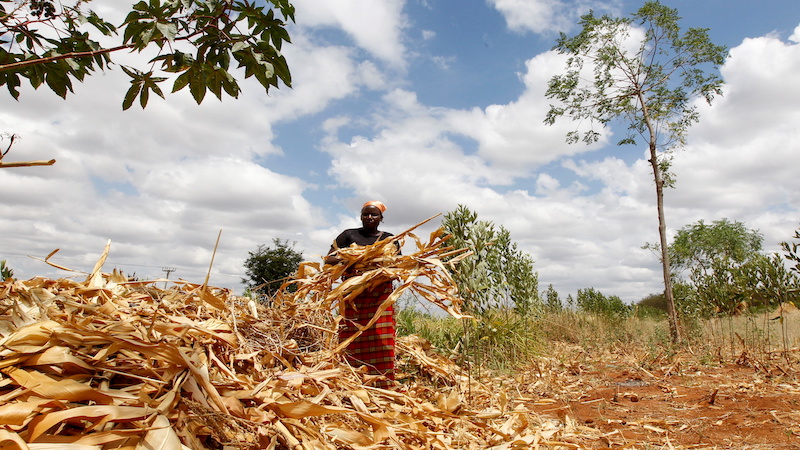Measures to adapt to climate change are often seen as the Cinderella of climate action – largely ignored and under-funded, garnering only a fraction of the attention and money enjoyed by their wealthier stepsister: efforts to cut planet-heating emissions.
That image is even more true to life when it comes to attracting money from private investors. While producing renewable energy offers easily quantifiable results and predictable revenue streams, projects to lessen the negative effects of drought or rising seas are regarded as hard to gauge and nearly impossible to monetise.
There’s no money to be made from adaptation and so private investors steer well clear of it, the common argument goes.
The numbers seem to back this up: the private sector contributed to just over 2% of the average $63 billion per year in global adaptation finance tracked by Climate Policy Initiative (CPI), an international research group, during 2021 and 2022. That is a rounding error when compared with the estimated $215 billion a year needed by developing countries alone to boost their climate resilience, according to the UN Adaptation Gap report.
But some climate finance experts suggest this is only a partial and misleading picture, perpetuated through a lack of data and information.
Morgan Richmond, lead analyst for CPI’s Adaptation and Resilience workstream, says private investments in adaptation are likely to be significantly underestimated as a result of the colossal challenge in tracking them.
“Basically no private-sector institution is currently self-identifying its investments as adaptation even when it could,” she told Climate Home.
Re-evaluating private sector adaptation
An asset manager, for example, could inject some cash into a food company’s efforts to reduce heat-related crop losses along its supply chain. Its primary goal might be the protection of the firm’s productivity and, ultimately, the financier’s bottom line. In doing so, it also helps farmers better withstand the impacts of climate change. Yet, without reporting requirements or specific incentives to spotlight that, what is essentially an adaptation investment falls into an information black hole.
The limited data available on private-sector adaptation finance in turn reinforces the mantra that there are limited or no viable business models for adaptation, CPI wrote in a recent report highlighting its new efforts to bring more of these finance flows to light.
Women plant mangrove saplings along the riverbanks of the Matla river in the Sundarbans, India, to combat the impacts of climate change. (Photo: Avijit Ghosh / Climate Visuals)
Having developed a more sophisticated tracking mechanism, CPI found private adaptation investments were on average more than four times higher than previously thought in the period from 2019 to 2022. While researchers believe this is still an underestimate, they hope that better identification and recognition of finance flows will encourage more businesses and investors to become active in the adaptation space.
“The idea is to create a common language and allow institutions to get a better sense of what their peers are doing,” said CPI’s Richmond. “Hopefully that creates a sense of the market shift that is happening and those institutions will want to be part of it.”
Some multinational firms – including Nestlé, Danone and Unilever – say they have taken steps, including promoting regenerative green agriculture techniques, to enhance the resilience of their global supply chains to climate shocks. But, outside of the food industry, business action to promote adaptation action has so far been limited despite the growing risks to revenues.
It’s time to end the UN’s artificial divide between biodiversity and climate
In late 2022, at COP27, the US Agency for International Development (USAID) launched a bid to spur more private-sector interest in building climate resilience under its PREPARE Call to Action. In an update on its website this year, it says that 39 companies and partners have so far made voluntary commitments that will mobilise more than $3 billion to help people better manage the impacts of climate change.
The commitments include technologies to expand climate information and early warning systems, new financial products and services, innovations for climate-smart food systems and insurance solutions, according to USAID.
Overcoming risk aversion
Despite this government-led push and efforts to capture finance flows better in the data, many barriers remain in trying to channel more private funding into adaptation, especially in the poorer developing countries at the forefront of the climate crisis. Uncertain parameters for assessing the success of adaptation measures – and putting a price on the risk of funding them – reduces appetite among profit-seeking institutions, experts say.
At the UN level, diplomats and experts are now working on a list of indicators for the Global Goal on Adaptation, a vague concept that was enshrined in the Paris Agreement in 2015 and intended to increase resilience-boosting efforts, especially in developing nations.
Parametric triggers: How small islands can escape the climate-poverty trap
A long-awaited playbook for putting the goal into practice, agreed at COP28 in Dubai last year, “recognises the importance” of the private sector – among various actors – in delivering it, though it does not provide specifics on what businesses should do.
One emerging attempt to overcome hurdles for adaptation funding involves “blended finance” mechanisms that bring together the public and private sectors. A public institution, such as a development bank or a government agency, provides early-stage concessional capital or guarantees that take on a substantial share of the project’s risk. This approach can lessen private financiers’ concerns and convince them to contribute funding that would otherwise not be made available.
In its latest report on international climate finance for developing countries, released in May, the
Read More


